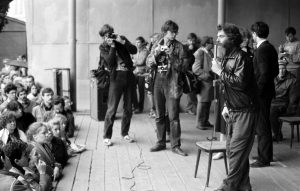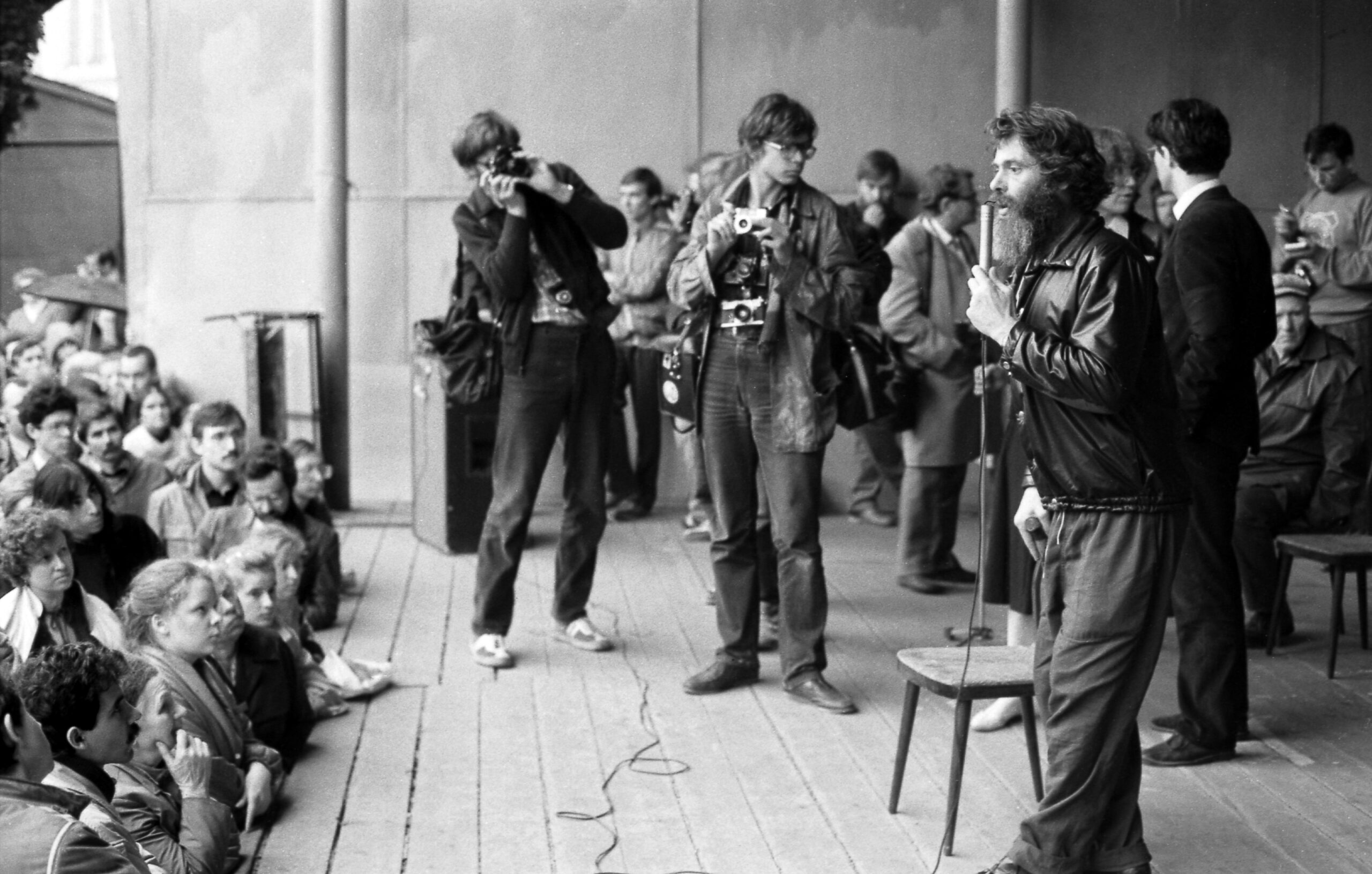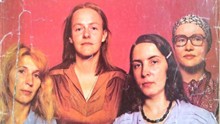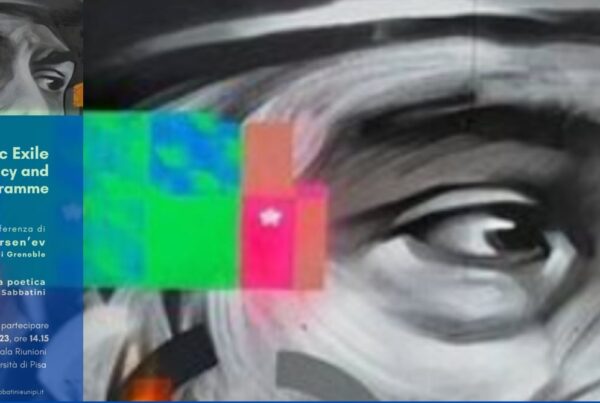
Photo: Vladimir Mekler © 1988 (homepage)
Date: 14th June 1988
Place: Leningrad
Description:
It was the 14th of June 1988, and throughout the evening, I had felt that an historical event was playing out before my eyes. For several hours, a crowd of people had stood in front of me, listening in complete silence to other people speaking from the stage. The silence was absolute – the people gathered in Leningrad’s Yusupov Garden (Iusupovskii sad) were straining to hear, they were holding their breath to catch every word. I stood on that stage, where concerts are performed in summer, and, together with Elena Zelinskaia, led the mass of people in remembering the victims of political repression. That evening, words were heard that previously we had not dared to say out loud, and they were spoken by people who had previously not been allowed to speak in public.
Elena and I led this historical event; we introduced the speakers, connected their arguments and gave a commentary. I think this lasted about three hours, but when we decided it was time to draw things to a close, imagining that people would be getting tired, we realised that, on the contrary, they were still ready to listen. It was the height of summer and at ten in the evening it was completely light, which reinforced the feeling that it was too early to go home. And in fact, here and there in the garden, groups of people were gathering in the strange light to discuss what they had heard.
That evening is now considered to be the moment the Leningrad (St. Petersburg) “Memorial” Group came into being. Thirty years later, on 14th June 2018, many of the people who were present that day gathered again in the Yusupov Garden. Many others were no longer with us. I wasn’t there either, and nor was Elena Zelinskaia as for the last few years both of us have lived outside the ‘new’ Russia.
In 1988, during the third year of Perestroika, memories of past repression by the Soviet state began to emerge. It cannot be said that the topic had been completely outlawed in the USSR, but since the 1970s, a thick veil of oblivion had been thrown over many events, and the revelations of Solzhenitsyn and others had been deemed anti-Soviet, dangerous and punishable. The monstrous terror of 1937-1938 which led to the deaths of millions of people was only vaguely spoken about and regarded as the consequence of the “cult of personality,” although the identity of the “personality” in question was never mentioned.
During Perestroika, when the authorities very cautiously opened up previously forbidden spaces, the events of the Great Terror gradually became public knowledge and for most people, it was a revelation. But not for me. My father had a strange hobby – he collected materials about the Stalinist repressions. Among them were typewritten texts, for example, a letter from Fёdor Raskolnikov to Stalin, books about the gulag system, which had been published during the Khrushchevian thaw and were then removed from libraries, and also the results of his own research – lists, cards and so on.
I remember being struck by a group photo of members of the Soviet government (or maybe the Central Committee of the Communist Party) in the 1920s – my father had placed crosses to blank out the heads of those who had since been executed; only a few heads were left uncovered by those crosses. My father hid all this material in the second row of our bookcase, behind the collected works of approved classics, so that our guests couldn’t see it.In 1987, on the 50th anniversary of the beginning of the Great Terror, people began to talk about the repressions more often. The topics covered by Soviet mass media changed and people began to change too. As my compatriots became more and more emancipated before my eyes, I too grew towards freedom. I had already been working for a year at the Soviet Cultural Foundation, under the guidance of its president Dmitrii Likhachev and the USSR’s first lady, Raisa Gorbachёva. The foundation’s offices had become an alternative point of reference to the by now inert Ministry of Culture and a wide variety of visitors passed through our doors. Many – at least in Leningrad – had been active in the former underground (although we didn’t use this word at the time), and were the dissidents, avant-garde artists and supporters of the samizdat who had previously operated in the shadows. I already knew some of them from when I frequented Club-81, an association of non-conformist writers (although we didn’t use this definition either).
Among these figures, perhaps the most prominent was the poet Viktor Krivulin, who demonstrated a strong sense of civic commitment: he followed with interest our efforts to protect our city’s monuments, and for me came to represent a sort of living monument commemorating St. Petersburg culture. Fittingly, Krivulin ended up in the centre of the photograph, speaking, perhaps for the first time in his life, to a crowd of citizens. There were also well-known citizens who had not been part of the underground, but who now considered it necessary to participate in the social transformation taking place, which at the time was defined as democratic. The historians Gleb Lebedev and Dmitrii Machinskii, and the writers Nina Katerli and Samuil Lurie (who everyone called Sania) all spoke from that stage in the Iusupov Garden.
My close friend, publicist and writer, Elena Zelinskaia had created her own circle, the Epicentre Association which included the artist Iulii Rybakov (later a member of the State Duma) and the environmentalist Pёtr Kozhevnikov both of whom were among the organizers of the evening. The speeches could not fail to mention recent victims of repression; many of our contemporaries had been sent to the gulags for their beliefs, including Veniamin (Venia) Iofe and Viacheslav (Slava) Dolinin, who were key figures behind the rally and who became prominent names in “Memorial”.
Working at the Cultural Foundation gave me a valuable opportunity; I was able to send requests to the city authorities to ask for permission to hold rallies, something totally unheard of under the Soviet system. I had to state on the official request, the topic of the rally, the place where it would be held and the expected number of participants. Thanks to its connections with Likhachev and Gorbacheva, the Cultural Foundation was respected by the authorities, and I had managed to receive permission more than once and I got it this time too. We wanted to create the right atmosphere for the rally, and so we chose to begin the evening by broadcasting the guitar chords and words of Galich:
“The clouds gather towards Abakan, / The clouds are slowly gathering … / They feel the warmth, I’m sure / While here rests an ancient ice! / I’m a horseshoe frozen into the track / Into the ice that I hacked with my pick! / They weren’t for nothing the twenty years / I spent in those camps”.
There was no need to announce who had written and was singing this song. Everyone recognised the hoarse voice of the bard-dissident and knew of his tragic fate.
When she opened the rally, Elena Zelinskaia repeated the words of the folklore hero Till Eulenspiegel who in taking vengeance for the death of his father burned by the Spanish Inquisition, cried out, “On my chest, throb the ashes of Klaas, my father”. It was not only Elena who used this battle cry; the philologist Marina Zhzhёnova, daughter of the actor Georgii Zhzhёnov, who despite being beloved by the Soviet public had spent 17 years in a gulag, also alluded to this idea of smoldering ashes.
I remember Marina’s speech well, as much of what she said reminded me of my own experience. She too had been different from her peers as, thanks to her father, she had always known the truth about Stalinism, a truth that now everyone had to know. She was adamant that there had to be a memorial to the victims. She demanded public acts of repentance and insisted that the names of the executioners be made known. It was our duty to create an association that brought back into the light all those names turned to dust. It was the civic duty of the children and grandchildren of Stalin’s victims to preserve the memory of those who were lost and those who had lived in fear for many years.
I also remember well how Sania Lurie began his speech: “I am standing in front of you, and I am afraid. I’m afraid that they will do me harm…”. We felt his physical fear, and his struggle with this fear. It was as if we could see him “squeezing the slave’s blood out of himself drop by drop” until, like Chekhov’s young man, he became a real and free human being. Were we afraid? Was I afraid? Probably not that evening. I felt that, together with Sania Lurie and the people listening to him, I was no longer afraid. At the end of the rally, as the crowd applauded, the creation of the Leningrad “Memorial” was announced from the stage. A wonderful wind of freedom began to blow over us and on that June night in 1988, it seemed to those of us in the Iusupov Garden that this wind would never be subdued…
Michail Talalay
[31st December 2022]
Translation by Tammy Corkish
To cite this article:
Michail Talaly, Leningrad, 14th June 1988. The Story of a Photograph, in Voci libere in URSS. Letteratura, pensiero, arti indipendenti in Unione Sovietica e gli echi in Occidente (1953-1991), a cura di C. Pieralli, M. Sabbatini, Firenze University Press, Firenze 2021-, <vocilibereurss.fupress.net>.
eISBN 978-88-5518-463-2
© 2021 Author(s)
Content license: CC BY 4.0





